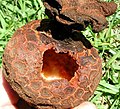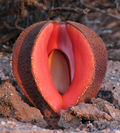| Hydnora | |
|---|---|
 | |
| Hydnora africana | |
| Scientific classification | |
| Kingdom: | Plantae |
| Clade: | Tracheophytes |
| Clade: | Angiosperms |
| Clade: | Magnoliids |
| Order: | Piperales |
| Family: | Aristolochiaceae |
| Subfamily: | Hydnoroideae |
| Genus: | Hydnora Thunb. |
| Synonyms [1] | |
AphyteiaAch. | |
Hydnora is a group of parasitic plants described as a genus in 1775. [2] [3] It is native to Africa, Madagascar, and the Arabian Peninsula. [1] [4] [5] Hydnora pollinates through brood-site mimicry. This is a method of pollination in which the plant emits a smell that is attractive to insects, so that the plant can trap the insect and allow it to take pollen so that it can pollinate other Hydnora. [6] Hydnora cannot photosynthesize and rely on host plants for nutrients. They are plants that are rooted underground and have the ability to damage infrastructures by bursting through pavements. [7]





